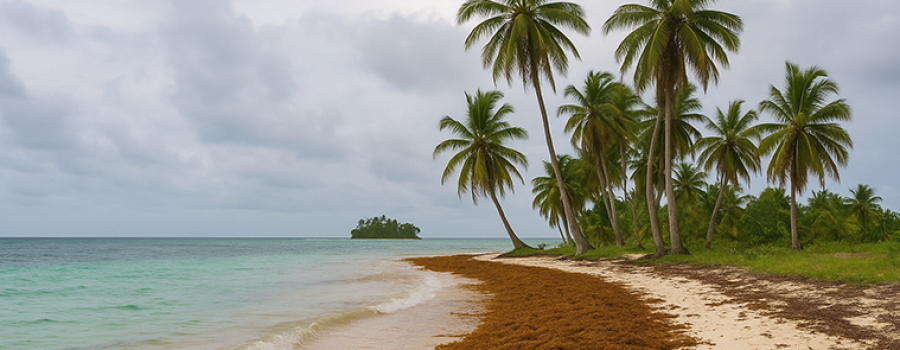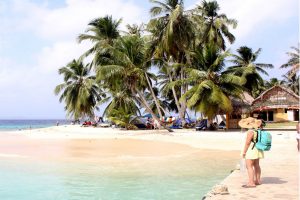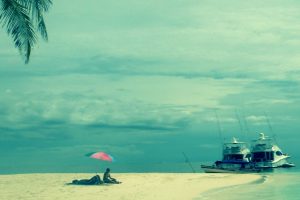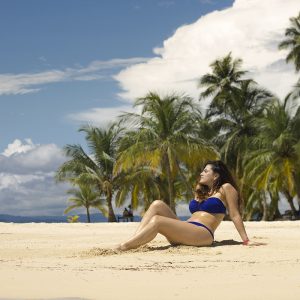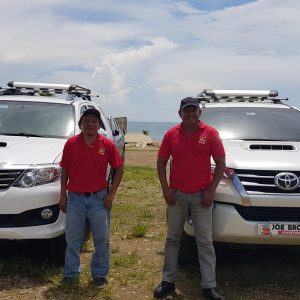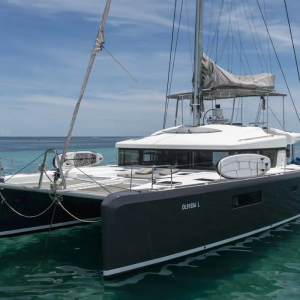Sargassum in San Blas has become an increasingly visible issue, especially during the rainy season. This brown macroalgae floats on the ocean’s surface thanks to small gas-filled bladders and, while it plays an important ecological role, its excessive presence threatens the pristine coastlines and communities of the region.
What is Sargassum?
Sargassum is a brown macroalgae that floats on the ocean’s surface thanks to small gas-filled bladders. It naturally forms large floating mats in tropical and subtropical waters and provides shelter for a variety of marine species.
However, in recent years, excessive amounts of sargassum have reached coastal areas, including the pristine beaches of San Blas, causing environmental and economic challenges.
Sargassum in San Blas During the Rainy Season
The San Blas Islands, located in the Guna Yala region of Panama, are world-renowned for their clear turquoise waters and white sandy beaches. Unfortunately, between May and November—the rainy season—the presence of sargassum increases significantly along the coast.
This rise is due to changes in ocean temperature, current patterns, and the higher influx of nutrients from land to sea during rainy periods.
Impacts on Local Communities and Tourism
The arrival of large sargassum blooms affects multiple aspects of life in San Blas:
-
Access to the ocean becomes difficult due to large piles of seaweed on the shores.
-
Fishing practices are disrupted, particularly for small-scale fishers.
-
Tourism declines as visitors face unpleasant odors and reduced beach appeal.
These effects can be especially hard on the local Guna communities, whose livelihoods often depend on tourism and sustainable marine practices.
This might also interest you: Best time to visit San Blas Islands
Why Does Sargassum Increase in the Rainy Season?
Several interconnected factors contribute to the seasonal increase:
1. Rainfall and Nutrient Runoff
Heavy rains wash agricultural and urban runoff into the ocean, supplying nutrients that fuel the growth of sargassum.
2. Warmer Ocean Temperatures
Climate change has raised ocean temperatures, which accelerates the growth of these algae.
3. Changing Ocean Currents
Altered currents can push massive sargassum blooms from the central Atlantic toward Caribbean coasts, including Panama.
Inclusive Strategies to Tackle the Problem of the Sargassum in San Blas
San Blas communities, organizations, and visitors can take part in sustainable and inclusive solutions:
-
Regular monitoring of sargassum movements using satellite tools.
-
Eco-conscious removal of sargassum, avoiding damage to marine life.
-
Public awareness campaigns to educate tourists and locals alike.
-
Research and innovation into using collected sargassum for biofuel, compost, or construction materials.
Final Thoughts
Sargassum in San Blas is a growing challenge that intensifies during the rainy season. But by understanding its causes and promoting inclusive, community-driven action, it’s possible to preserve the natural beauty and cultural richness of the islands.
Everyone—visitors, residents, and policymakers—has a role to play in protecting San Blas and turning a seasonal challenge into a sustainable opportunity.


